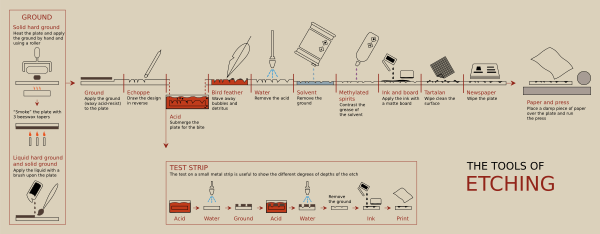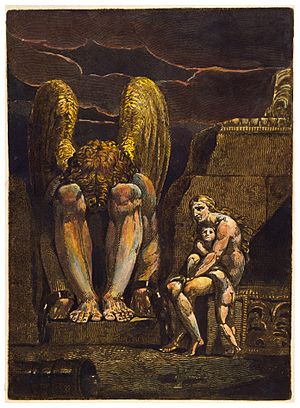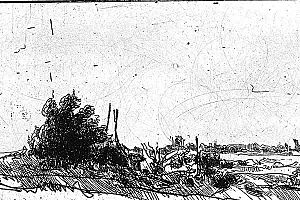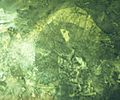Etching facts for kids
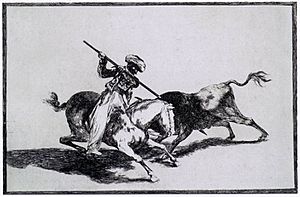
Etching is made by drawing lines through a protective coating on a copper or zinc plate. The plate is then placed into acid. The acid cuts into the unprotected parts of the surface to create a design in the metal.
The printing is done by rolling an ink pad across the surface. The ink sinks into the intaglio (cut) surface, and rolls off the waxed surface off the plate. The metal plate is then pressed onto paper.
History
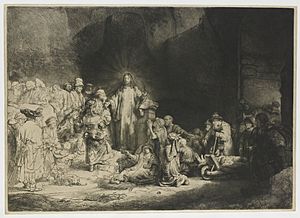
Origin
Etching by goldsmiths and other metal-workers in order to decorate metal items such as guns, armour, cups and plates has been known in Europe since the Middle Ages at least, and may go back to antiquity. The elaborate decoration of armour, in Germany at least, was an art probably imported from Italy around the end of the 15th century—little earlier than the birth of etching as a printmaking technique.
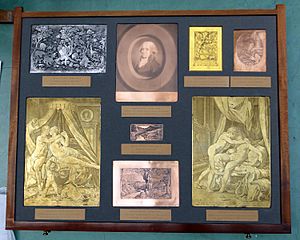
The process as applied to printmaking is believed to have been invented by Daniel Hopfer (circa 1470–1536) of Augsburg, Germany. Hopfer was a craftsman who decorated armour in this way, and applied the method to printmaking, using iron plates (many of which still exist). Apart from his prints, there are two proven examples of his work on armour: a shield from 1536 now in the Real Armeria of Madrid and a sword in the Germanisches Nationalmuseum of Nuremberg. An Augsburg horse armour in the German Historical Museum, Berlin, dating to between 1512 and 1515, is decorated with motifs from Hopfer's etchings and woodcuts, but this is no evidence that Hopfer himself worked on it, as his decorative prints were largely produced as patterns for other craftsmen in various media.
The switch to copper plates was probably made in Italy, and thereafter etching soon came to challenge engraving as the most popular medium for artists in printmaking. Its great advantage was that, unlike engraving where the difficult technique for using the burin requires special skill in metalworking, the basic technique for creating the image on the plate in etching is relatively easy to learn for an artist trained in drawing. On the other hand, the handling of the ground and acid need skill and experience, and are not without health and safety risks, as well as the risk of a ruined plate.
Variants
Aquatint uses acid-resistant resin to achieve tonal effects.
Soft-ground etching uses a special softer ground. The artist places a piece of paper (or cloth etc. in modern uses) over the ground and draws on it. The print resembles a drawing.
Relief etching was invented by William Blake in about 1788, and he has been almost the only artist to use it in its original form. However, from 1880–1950 a photo-mechanical ("line-block") variant was the dominant form of commercial printing for images. A similar process to etching, but printed as a relief print, so it is the "white" background areas which are exposed to the acid, and the areas to print "black" which are covered with ground. Blake's exact technique remains controversial. He used the technique to print texts and images together, writing the text and drawing lines with an acid-resistant medium.
Carbograph etching was invented in 2006 and yields an image like that of a charcoal drawing:
www.randhuebsch.com/carbograph.html
Printmaking technique in detail
A waxy acid-resist, known as a ground, is applied to a metal plate, most often copper or zinc but steel plate is another medium with different qualities. There are two common types of ground: hard ground and soft ground.
Hard ground can be applied in two ways. Solid hard ground comes in a hard waxy block. To apply hard ground of this variety, the plate to be etched is placed upon a hot-plate (set at 70 degrees C), a kind of metal worktop that is heated up. The plate heats up and the ground is applied by hand, melting onto the plate as it is applied. The ground is spread over the plate as evenly as possible using a roller. Once applied the etching plate is removed from the hot-plate and allowed to cool which hardens the ground.
After the ground has hardened the artist "smokes" the plate, classically with 3 beeswax tapers, applying the flame to the plate to darken the ground and make it easier to see what parts of the plate are exposed. Smoking not only darkens the plate but adds a small amount of wax. Afterwards the artist uses a sharp tool to scratch into the ground, exposing the metal.

The second way to apply hard ground is by liquid hard ground. This comes in a can and is applied with a brush upon the plate to be etched. Exposed to air the hard ground will harden. Some printmakers use oil/tar based asphaltum or bitumen as hard ground, although often bitumen is used to protect steel plates from rust and copper plates from aging.
Soft ground also comes in liquid form and is allowed to dry but it does not dry hard like hard ground and is impressionable. After the soft ground has dried the printmaker may apply materials such as leaves, objects, hand prints and so on which will penetrate the soft ground and expose the plate underneath.
The ground can also be applied in a fine mist, using powdered rosin or spraypaint. This process is called aquatint, and allows for the creation of tones, shadows, and solid areas of color.
The design is then drawn (in reverse) with an etching-needle or échoppe. An "echoppe" point can be made from an ordinary tempered steel etching needle, by grinding the point back on a carborundum stone, at a 45–60 degree angle. The "echoppe" works on the same principle that makes a fountain pen's line more attractive than a ballpoint's: The slight swelling variation caused by the natural movement of the hand "warms up" the line, and although hardly noticeable in any individual line, has a very attractive overall effect on the finished plate. It can be drawn with in the same way as an ordinary needle.
The plate is then completely submerged in a solution that eats away at the exposed metal. Ferric chloride may be used for etching copper or zinc plates, whereas nitric acid may be used for etching zinc or steel plates. Typical solutions are 1 part FeCl3 to 1 part water and 1 part nitric to 3 parts water. The strength of the acid determines the speed of the etching process.
- The etching process is known as biting (see also spit-biting below).
- The waxy resist prevents the acid from biting the parts of the plate which have been covered.
- The longer the plate remains in the acid the deeper the "bites" become.
During the etching process the printmaker uses a bird feather or similar item to wave away bubbles and detritus produced by the dissolving process, from the surface of the plate, or the plate may be periodically lifted from the acid bath. If a bubble is allowed to remain on the plate then it will stop the acid biting into the plate where the bubble touches it. Zinc produces more bubbles much more rapidly than copper and steel and some artists use this to produce interesting round bubble-like circles within their prints for a Milky Way effect.
The detritus is powdery dissolved metal that fills the etched grooves and can also block the acid from biting evenly into the exposed plate surfaces. Another way to remove detritus from a plate is to place the plate to be etched face down within the acid upon plasticine balls or marbles, although the drawback of this technique is the exposure to bubbles and the inability to remove them readily.
For aquatinting a printmaker will often use a test strip of metal about a centimetre to three centimetres wide. The strip will be dipped into the acid for a specific number of minutes or seconds. The metal strip will then be removed and the acid washed off with water. Part of the strip will be covered in ground and then the strip is redipped into the acid and the process repeated. The ground will then be removed from the strip and the strip inked up and printed. This will show the printmaker the different degrees or depths of the etch, and therefore the strength of the ink color, based upon how long the plate is left in the acid.
The plate is removed from the acid and washed over with water to remove the acid. The ground is removed with a solvent such as turpentine. Turpentine is often removed from the plate using methylated spirits since turpentine is greasy and can affect the application of ink and the printing of the plate.
Spit-biting is a process whereby the printmaker will apply acid to a plate with a brush in certain areas of the plate. The plate may be aquatinted for this purpose or exposed directly to the acid. The process is known as "spit"-biting due to the use of saliva once used as a medium to dilute the acid, although gum arabic or water are now commonly used.
A piece of matte board, a plastic "card", or a wad of cloth is often used to push the ink into the incised lines. The surface is wiped clean with a piece of stiff fabric known as tarlatan and then wiped with newsprint paper; some printmakers prefer to use the blade part of their hand or palm at the base of their thumb. The wiping leaves ink in the incisions. You may also use a folded piece of organza silk to do the final wipe. If copper or zinc plates are used, then the plate surface is left very clean and therefore white in the print. If steel plate is used, then the plate's natural tooth gives the print a grey background similar to the effects of aquatinting. As a result, steel plates do not need aquatinting as gradual exposure of the plate via successive dips into acid will produce the same result.
A damp piece of paper is placed over the plate and it is run through the press.
Images for kids
-
The etched carnelian beads in this necklace from the Royal Cemetery of Ur dating to the First Dynasty of Ur (2600-2500 BCE) were probably imported from the Indus Valley.
See also
 In Spanish: Aguafuerte para niños
In Spanish: Aguafuerte para niños


